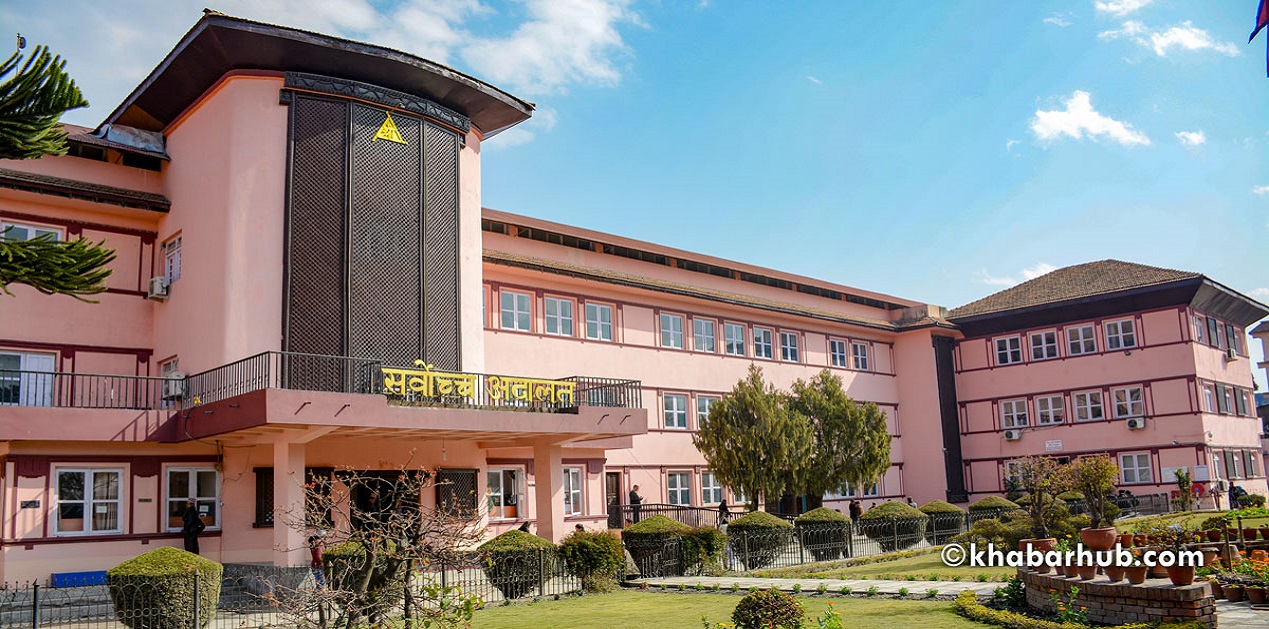The Crisis
For more than one month now, Nepal’s judicial system has come to a partial halt. The Nepal Bar Association (NBA) is protesting against Chief Justice Cholendra Shumsher Jung Bahadur Rana and demanding his unconditional resignation. Other than the NBA, several lawyers’ associations, former judges of the Supreme Court have held sit-in protests demanding the resignation. NBA alleges that the Chief Justice had sought a cabinet position for his brother-in-law Gajendra Bahadur Hamal who was inducted in the Dueba cabinet as the Industry, Commerce and Supplies Minister on October 10, 2021.[1] After fierce opposition from the civil society and lawyers’ association, Minister Hamal had resigned within 48 hours of his appointment. Meanwhile, Hamal’s resignation did not suffice NBA’s demand for Chief Justice’s resignation.
Several leaders in the Nepali Congress had termed Hamal’s appointment as a hasty move by the top leadership.[2] On the other hand, lawyers’ associations have called it the undermining of democratic values and violation of the separation of power between the judiciary, executive and politics. Therefore, Hamal’s appointment and resignation had been a significant setback to the Nepali Congress government. Nepali Congress had been bargaining with its other coalition partners in the government, including the Maoists and Nepal Communist Socialist Madhav Nepal, on cabinet berths. In the absence of an understanding with the coalition partners in the government, Prime Minister Dueba was running almost all major ministries on an ad hoc basis for more than a month since July 2021.[3] Therefore, Nepali Congress had the challenging task of appointing Hamal as the Commerce and Industry Minister.
Chief Justice Rana is also accused of “entering a quid pro quo deal with the executive and seeking delay in hearing of cases filed against the appointments made to constitutional bodies where Rana has a conflict of interest.”[4] Although these appointments were made by the previous government led by KP Oli, they have made the headlines since then. The NBA pushed for computer-based random case allotments in the Supreme Court, High Courts and districts courts. However, Chief Justice Rana was unwilling to introduce any such system as he would have lost the power as the Master of Roster.
Amidst these crises, a full-court meeting of 18 Supreme Court judges excluding the Chief Justice decided on a procedure where the allotment of the cases is based on the lottery system. The regulations/orders for such a procedure were published in the Nepal Gazette on November 22, 2021. With the new regulation coming into effect on December 01, 2021, the Chief Justice will no longer be the Mater of Roster.[5]
Alleged Nexus
The Nepali media has played a key role in alleging a reported bargain between the Chief Justice and the government in appointing Hamal as minister. Chief Justice Cholendra-led five-member Constitutional Bench had pronounced a favourable verdict for Sher Bahadur Deuba while hearing a case against the then Prime Minister KP Sharma Oli for the latter’s unconstitutional moves to dissolve the parliament and calling for early elections by the yearend in May 2021. Earlier in March 2021, the Supreme Court had also played an important role in ending a year-long political deadlock between two Chairman of the Nepal Communist Party (NCP), namely KP Oli and Pushpa Kamal Dahal ‘Prachanda’. Within a few months of the political merger of UML and the Maoists into one single NCP in 2018, the two chairs of the party had been fighting to claim the top post in the government. Prachanda wanted to be appointed Prime Minister for the next half term, while Oli was adamant in not allowing any concessions to Prachanda either in the government or the party. To end the logjam, the court had split the NCP into their older forms as CPN-UML led by Oli and Maoists Party led by Prachanda. Although these apex court verdicts were hailed as they ended a long-standing political instability in the country, present allegations against the Chief Justice allegedly indicate otherwise.
Caught in Crisis
With the implementation of the controversial 2015 Constitution, it was believed that the country was moving towards a mature and stable political order. Against this assumption, politics have not let the process of development and government improve. Even during the COVID-19, leadership had failed to address the issue of corruption in procuring lifesaving medicines and providing timely help to millions of Nepalese migrants stranded across the world, especially those stuck at the India-Nepal border. Amidst the COVID-19 crisis, the judiciary was busy hearing cases on the dissolution of the parliament in December 2020, new laws dealing with splitting the party by KP Oli and several others cases. Therefore, the present judicial crisis is in stark contrast to a general belief regarding the apex court as the most independent body in the country.
The Faceoff
The crises have further deteriorated as Chief Justice Rana has refused to resign and continues to deny any allegations against him.[6] As a result, the judicial system has come to a standstill and the apex court has been unable to hold any hearings other than a few writ petitions. Meanwhile, there are no proven charges against Chief Justice Rana. Hence, any constitutional or judicial moves against him would need a strong base, not just the media reports and perceived allegations. Also, since a Chief Justice is appointed through a constitutional process by the President of Nepal, he can either choose to resign or be impeached. As per Article 101 (2) of the Nepalese Constitution, “at least one-fourth majority of the total number of the then members of the House of Representatives may be table a motion of impeachment against the Chief Justice”.[7] And the motion can only be brought before the parliament “on the grounds of serious violation of the Constitution and law, his or her incompetence, misbehaviour or failure to discharge the duties”.[8] Hence, it is very unlikely that the standoff between Chief Justice and the NBA will end anytime soon due to the complexity of the situation. Meanwhile, for smooth functioning of the court, five coalition partners of the Nepali Congress-led government have suggested the Chief Justice go on an extended leave and depute an acting Chief Justice in place.
The Past
With the reinstating of the democracy in 1990, the judiciary in Nepal was believed to have emerged as an independent institution, away from the high-handedness of the royal court. However, against this assumption, the King always enjoyed influence over the judiciary in Nepal.[9] The Darbari judges had always protected the royal regime, including King’s unanimous decisions to impose national emergencies in 2005. Therefore, over the years, the judiciary has been under scrutiny in Nepal. It is especially so in the matters of political appointments and promotion of the judges in the apex court. There are several cases where judges were given executive roles and continued as a judge. For instance, in 2013, Chief Justice Khil Raj Regmi was appointed as the de facto Prime Minister by the then President Ram Baran Yadav until a new interim government was elected. Despite an intensified demand for his resignation due to concerns of separation of power between judiciary and executive of the country Regmi had continued as the de facto Prime Minister and Chairman of the Interim Election Government. He remained Chief Justice until the election of a Nepali Congress-led new government in February 2014.[10]
To conclude, the fall of the monarchy in 2006 and the rise of democracy had strengthened the belief of an independent judiciary in Nepal. However, democracy and democratic institutions are still evolving in Nepal, and it might take many more decades for the country and its leadership to come to terms with the principle of separation of powers.
Endnotes:
[1] “Gajendra Hamal resigns as minister after controversy” Kathmandu Post, October 10, 20201, https://bit.ly/3FxfPqZ.
[2] “Minister position for non-parliamentarian ‘close to’ chief justice causes uproar” Kathmandu Post, October 09, 2021, https://bit.ly/3iKxmCp.
[3] “Deuba still struggles to appoint ministers” Kathmandu Post, October 06, 2021, https://bit.ly/3lk33El.
[4] “NBA threatens to intensify stir against CJ” Himalayan Times, November 25, 2021, https://thehimalayantimes.com/nepal/nba-threatens-to-intensify-stir-against-cj.
[5] “With lottery system, chief justice loses the master of roster role” Kathmandu Post, November 25, 2021, https://bit.ly/3DSsCTv.
[6] “Lawyers press for CJ's impeachment” Himalaya Times November 27, 2021, https://thehimalayantimes.com/nepal/lawyers-press-for-cjs-impeachment.
[7] “Constitution of Nepal” Article 101 (p. 69), Government of Nepal, https://www.mohp.gov.np/downloads/Constitution%20of%20Nepal%202072_full_english.pdf.
[8] Ibid.
[9] “The principle of the thing: Nepal’s king and the rule of law” Himal, July 22, 2005, https://www.himalmag.com/the-principle-of-the-thing-nepals-king-and-the-rule-of-law/.
[10] “Regmi calls its quits as CJ” Kathmandu Post, February 11, 2014, https://kathmandupost.com/miscellaneous/2014/02/11/regmi-calls-its-quits-as-cj.
(The paper is the author’s individual scholastic articulation. The author certifies that the article/paper is original in content, unpublished and it has not been submitted for publication/web upload elsewhere, and that the facts and figures quoted are duly referenced, as needed, and are believed to be correct). (The paper does not necessarily represent the organisational stance... More >>
Image Source: https://nyc3.digitaloceanspaces.com/imagekhabarhub/en/uploads/2020/03/supreme_Court.jpg










Post new comment